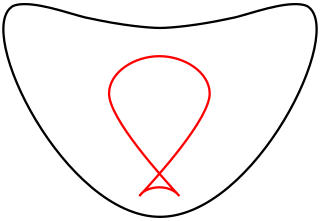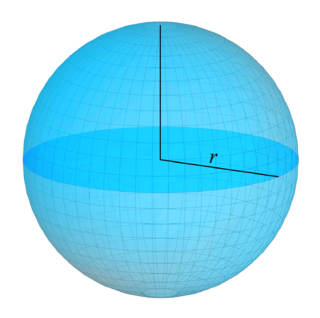
Algebraic geometry is a branch of mathematics, classically studying zeros of multivariate polynomials. Modern algebraic geometry is based on the use of abstract algebraic techniques, mainly from commutative algebra, for solving geometrical problems about these sets of zeros.

In geometry, the tangent line to a plane curve at a given point is the straight line that "just touches" the curve at that point. Leibniz defined it as the line through a pair of infinitely close points on the curve. More precisely, a straight line is said to be a tangent of a curve y = f(x) at a point x = c if the line passes through the point (c, f ) on the curve and has slope f'(c), where f' is the derivative of f. A similar definition applies to space curves and curves in n-dimensional Euclidean space.
Bézout's theorem is a statement in algebraic geometry concerning the number of common zeros of n polynomials in n indeterminates. In its original form the theorem states that in general the number of common zeros equals the product of the degrees of the polynomials. It is named after Étienne Bézout.

Algebraic varieties are the central objects of study in algebraic geometry, a sub-field of mathematics. Classically, an algebraic variety is defined as the set of solutions of a system of polynomial equations over the real or complex numbers. Modern definitions generalize this concept in several different ways, while attempting to preserve the geometric intuition behind the original definition.

In mathematics, an affine algebraic plane curve is the zero set of a polynomial in two variables. A projective algebraic plane curve is the zero set in a projective plane of a homogeneous polynomial in three variables. An affine algebraic plane curve can be completed in a projective algebraic plane curve by homogenizing its defining polynomial. Conversely, a projective algebraic plane curve of homogeneous equation h(x, y, t) = 0 can be restricted to the affine algebraic plane curve of equation h(x, y, 1) = 0. These two operations are each inverse to the other; therefore, the phrase algebraic plane curve is often used without specifying explicitly whether it is the affine or the projective case that is considered.

In algebraic geometry, a projective variety over an algebraically closed field k is a subset of some projective n-space over k that is the zero-locus of some finite family of homogeneous polynomials of n + 1 variables with coefficients in k, that generate a prime ideal, the defining ideal of the variety. Equivalently, an algebraic variety is projective if it can be embedded as a Zariski closed subvariety of .
In mathematics, a scheme is a mathematical structure that enlarges the notion of algebraic variety in several ways, such as taking account of multiplicities and allowing "varieties" defined over any commutative ring.
In mathematics, and especially in algebraic geometry, the intersection number generalizes the intuitive notion of counting the number of times two curves intersect to higher dimensions, multiple curves, and accounting properly for tangency. One needs a definition of intersection number in order to state results like Bézout's theorem.
In mathematics, a Cohen–Macaulay ring is a commutative ring with some of the algebro-geometric properties of a smooth variety, such as local equidimensionality. Under mild assumptions, a local ring is Cohen–Macaulay exactly when it is a finitely generated free module over a regular local subring. Cohen–Macaulay rings play a central role in commutative algebra: they form a very broad class, and yet they are well understood in many ways.
In abstract algebra, if I and J are ideals of a commutative ring R, their ideal quotient is the set
In mathematics, the Veronese surface is an algebraic surface in five-dimensional projective space, and is realized by the Veronese embedding, the embedding of the projective plane given by the complete linear system of conics. It is named after Giuseppe Veronese (1854–1917). Its generalization to higher dimension is known as the Veronese variety.
In algebraic geometry, Proj is a construction analogous to the spectrum-of-a-ring construction of affine schemes, which produces objects with the typical properties of projective spaces and projective varieties. The construction, while not functorial, is a fundamental tool in scheme theory.
In mathematics, the rational normal curve is a smooth, rational curve C of degree n in projective n-space Pn. It is a simple example of a projective variety; formally, it is the Veronese variety when the domain is the projective line. For n = 2 it is the plane conic Z0Z2 = Z2
1, and for n = 3 it is the twisted cubic. The term "normal" refers to projective normality, not normal schemes. The intersection of the rational normal curve with an affine space is called the moment curve.
In mathematics, particularly in the field of algebraic geometry, a Chow variety is an algebraic variety whose points correspond to effective algebraic cycles of fixed dimension and degree on a given projective space. More precisely, the Chow variety is the fine moduli variety parametrizing all effective algebraic cycles of dimension and degree in .
In mathematics, an algebraic variety V in projective space is a complete intersection if the ideal of V is generated by exactly codim V elements. That is, if V has dimension m and lies in projective space Pn, there should exist n − m homogeneous polynomials:

In projective geometry, a dual curve of a given plane curve C is a curve in the dual projective plane consisting of the set of lines tangent to C. There is a map from a curve to its dual, sending each point to the point dual to its tangent line. If C is algebraic then so is its dual and the degree of the dual is known as the class of the original curve. The equation of the dual of C, given in line coordinates, is known as the tangential equation of C. Duality is an involution: the dual of the dual of C is the original curve C.

In mathematics, a surface is a generalization of a plane. Unlike a plane, it need not be flat – that is, its curvature need not be zero. This is analogous to a curve generalizing a straight line. There are many more-precise definitions, depending on the context and the mathematical tools used to analyze the surface.
In algebraic geometry, a branch of mathematics, a Hilbert scheme is a scheme that is the parameter space for the closed subschemes of some projective space, refining the Chow variety. The Hilbert scheme is a disjoint union of projective subschemes corresponding to Hilbert polynomials. The basic theory of Hilbert schemes was developed by Alexander Grothendieck (1961). Hironaka's example shows that non-projective varieties need not have Hilbert schemes.
This is a glossary of algebraic geometry.
In algebraic geometry, the scheme-theoretic intersection of closed subschemes X, Y of a scheme W is , the fiber product of the closed immersions . It is denoted by .




















